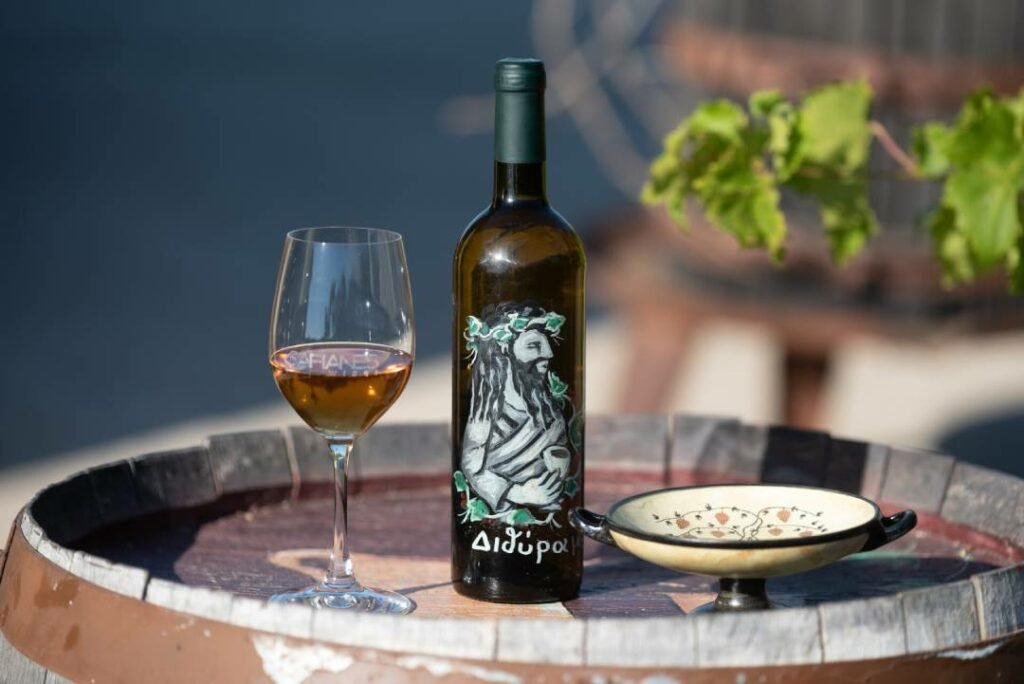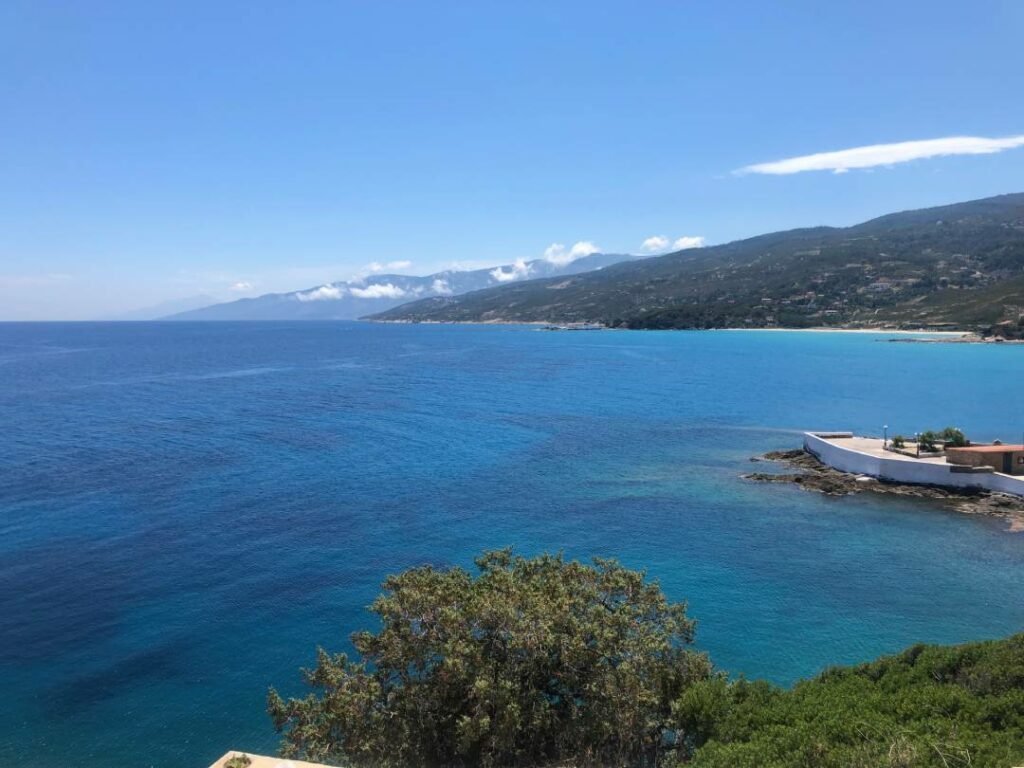Where Ancient Tales Merge With Modern Practices To Nurture A Harmonious Way Of Life, Including the Rich Tradition of Ikarian Wine.
Deriving its name from the famed legend of Icarus, the island is named after the boy who flew too close to the sun. People say that Icarus’ body washed ashore the island after he lost his wings, and they named a large rock formation on the island ‘The Rock of Icarus’ in his honor.
Ikaria also boasts the birthplace of the Greek god of wine, Dionysus. People cite a cave in the region of Drakanum as the actual place where Dionysus was born, and say that the nymph-nanny, Makris, nursed him. They also identify this as the island’s oldest known name. The cave is known as Iero, which translates to “holy place,” and was a clear sacred site of the followers of Dionysus. Many ancient relics associated with the cult have been found there.
The other ancient patron god of Ikaria is Artemis, goddess of wilderness. In the village of Nas, the remnants of her temple are still strewn upon its picturesque beach, and legend states that the ancient statue of the goddess was hidden somewhere within the neighboring river when the temple was torn down and the stone was used to build a church in the early 1800s.

Wines of Ikaria, known in antiquity as “Ikarian Wine” or “Pramnian Wine,” have been highlighted in some of humanity’s greatest literary scenes. Most notably, perhaps, is the mention of Pramnian wine by the great Greek poet, Homer, in both of his epics, The Iliad and The Odyssey. Often cited as an essential ingredient in the magical elixir of kykeon, Ikarian wine makes various literary appearances.
In the eleventh rhapsody of The Iliad, it is mentioned that Hecamede prepares a nourishing potion to restore the strength of Nestor and his friends,
“In it the woman, like unto the goddesses, had mixed for them Pramnian wine, and grated over it a goat’s-milk cheese with a brazen rasp, and sprinkled white flour upon it: then bade them drink, as soon as she had prepared the potion” (Homer, XI, p. 618-643).
In the tenth book of The Odyssey, kykeon is also cited with the same specific ingredients, yet is now used by the witch, Circe, for more malicious purposes,

“And she mixed them a potion with barley and cheese and pale honey added to Pramnian wine, but put into the mixture malignant drugs to make them forgetful of their own country (Homer, X, p. 234-236).
The Ikarian Wine has woven itself into the deep cultural fabric of Western literary tradition, and is an important facet in understanding its long-standing heritage on the island.
Ikaria is an island that has long been revered for the longevity of its people. Though perhaps more recognized in modern times through The Blue Zones research, there is a long and rich history detailing the island’s hearty people.
In the 17th century, Joseph Giorgirenis, the arch-bishop of Samos, traveled to various islands of the Aegean and described his account of their lifestyle in his book, A Description of the Present State of Samos, Nicaria, Patmos, and Mount Athos.
While in Ikaria, he wrote,
“The most commendable thing of this island is their air and water, both so healthful, that the people are very long lived, it being an ordinary thing to see persons of 100 years of age, which is a great wonder, considering how hardily they live” (p. 61).
In modern day, Dan Buettner of The National Geographic, alongside his team of scientists and demographers, identified five regions in the world with the highest populations of living centenarians today. They circled each zone on a map with a blue marker, thus entitling their research as “The Blue Zones.”

The five regions identified are Ikaria, Greece; Okinawa, Japan; Sardinia, Italy; Linda Loma, California; and Nicoya, Costa Rica. Each of these regions is considered to be a hot-spot of longevity, and are revered for their high quality of life and vitality of their populations.
Ikaria’s healthy Mediterranean diet, slow pace of life, and strong sense of community are some of the vital factors that contribute to their longevity. Not to mention a penchant for strong red wine and dancing whenever possible! Incredibly, Ikarians are nearly free of chronic disease and dementia, and the island continues its rich legacy of longevity and healthy living.
People described the ancient Pramnian wine of Ikaria as strong and thick and esteemed it for its apparent medicinal qualities. The ancient Greek historian Eparchides, who lived in the late 3rd century B.C., described the wine as, “neither sweet nor rich, but dry, hard, and of extraordinary strength.”
Pramnian wine was prescribed by the acclaimed historical doctors, Hippocrates and Galen, for uses ranging from healing an infected wound, to curing fits of depression and mental illness. The ancient Greek historian, Semos, also quoted,
“In Ikaria there is a rock, the so-called ‘Pramnos’, and next to it there is a high mountain, and on this mountain, they produce Pramnian wine, which is also called by some Pharmakites, meaning medicine.”
It was said that the Athenians deemed Pramnian wine unsuitable for symposiums, in which aristocratic men would drink and discuss philosophy, because the wine was too strong and would intoxicate the guests too quickly.
It is clear that the ancient Ikarians revered their wine, as Eparchides recorded that the name of their capital city was called Oinoe, meaning “abundant in wine,” and they referred to their own vines as “Dioynsian,” in reference to the god of wine.
Ikarians made their wine in clay amphorae, burying the wine underground and sealing the sides with a natural ash paste to protect from debris and oxidation. A stone slab with a centric hole acted as the top cover, and when wine was desired, the Ikarians had an ingenious way to remove the wine without unearthing the amphora. They created the sifouni, a siphon effect, with the simple objects of a pumpkin and a bamboo rod.

The bamboo rod would lower into the centric hole of the stone slab and into the amphora, and then attach to a hollow pumpkin that had been specially grown to accommodate this purpose. A small mouthpiece on the pumpkin allowed an individual to slowly suck in air, which in turn would cause the wine to transfer from the amphora into the pumpkin. The pumpkin would slowly fill with wine, and they were able to enjoy the wine freely, without risking oxidation of the whole batch.
The Afianes family still produces this ancient style of Greek Ikarian wine, in amphorae buried underground, and their symbol is that of the sifouni, in reference to the ancient Ikarian tradition.
© 2024 · Odyssey of Wine Tours
Developed by Dreamcoders